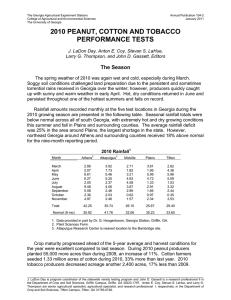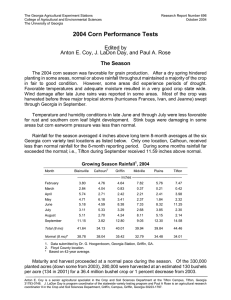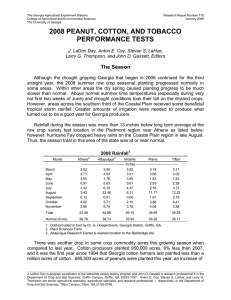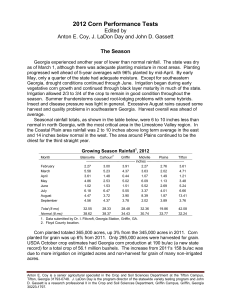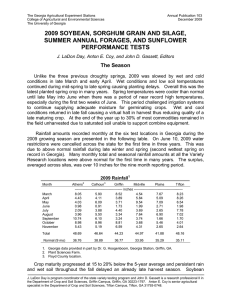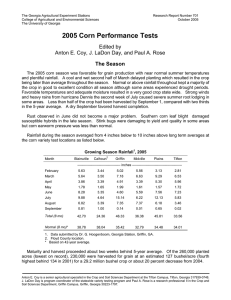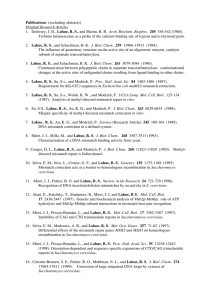Document 13145470
advertisement
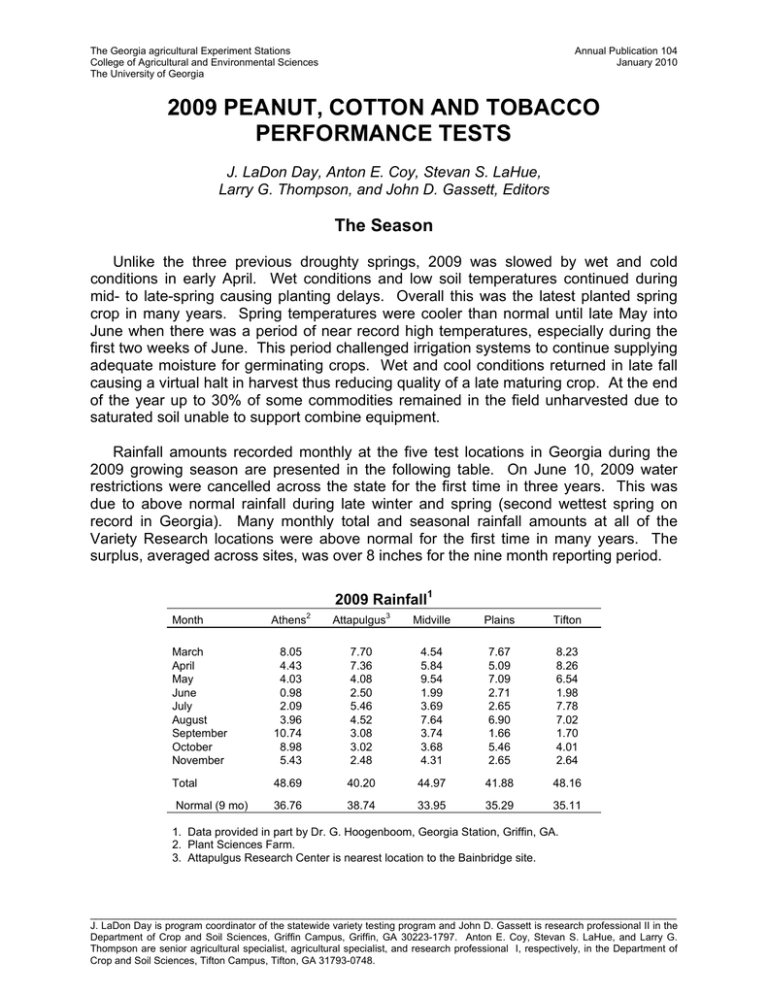
The Georgia agricultural Experiment Stations College of Agricultural and Environmental Sciences The University of Georgia Annual Publication 104 January 2010 2009 PEANUT, COTTON AND TOBACCO PERFORMANCE TESTS J. LaDon Day, Anton E. Coy, Stevan S. LaHue, Larry G. Thompson, and John D. Gassett, Editors The Season Unlike the three previous droughty springs, 2009 was slowed by wet and cold conditions in early April. Wet conditions and low soil temperatures continued during mid- to late-spring causing planting delays. Overall this was the latest planted spring crop in many years. Spring temperatures were cooler than normal until late May into June when there was a period of near record high temperatures, especially during the first two weeks of June. This period challenged irrigation systems to continue supplying adequate moisture for germinating crops. Wet and cool conditions returned in late fall causing a virtual halt in harvest thus reducing quality of a late maturing crop. At the end of the year up to 30% of some commodities remained in the field unharvested due to saturated soil unable to support combine equipment. Rainfall amounts recorded monthly at the five test locations in Georgia during the 2009 growing season are presented in the following table. On June 10, 2009 water restrictions were cancelled across the state for the first time in three years. This was due to above normal rainfall during late winter and spring (second wettest spring on record in Georgia). Many monthly total and seasonal rainfall amounts at all of the Variety Research locations were above normal for the first time in many years. The surplus, averaged across sites, was over 8 inches for the nine month reporting period. 2009 Rainfall1 Month Athens2 Attapulgus3 Midville Plains Tifton March April May June July August September October November 8.05 4.43 4.03 0.98 2.09 3.96 10.74 8.98 5.43 7.70 7.36 4.08 2.50 5.46 4.52 3.08 3.02 2.48 4.54 5.84 9.54 1.99 3.69 7.64 3.74 3.68 4.31 7.67 5.09 7.09 2.71 2.65 6.90 1.66 5.46 2.65 8.23 8.26 6.54 1.98 7.78 7.02 1.70 4.01 2.64 Total 48.69 40.20 44.97 41.88 48.16 36.76 38.74 33.95 35.29 35.11 Normal (9 mo) 1. Data provided in part by Dr. G. Hoogenboom, Georgia Station, Griffin, GA. 2. Plant Sciences Farm. 3. Attapulgus Research Center is nearest location to the Bainbridge site. _________________________________________________________________________________________________________ J. LaDon Day is program coordinator of the statewide variety testing program and John D. Gassett is research professional II in the Department of Crop and Soil Sciences, Griffin Campus, Griffin, GA 30223-1797. Anton E. Coy, Stevan S. LaHue, and Larry G. Thompson are senior agricultural specialist, agricultural specialist, and research professional I, respectively, in the Department of Crop and Soil Sciences, Tifton Campus, Tifton, GA 31793-0748. Crop maturity progressed at 15 to 20% below the 5-year average and persistent rain and wet soil throughout the fall delayed an already late harvest season. Peanut producers decreased acreage 26% less than last year which was the same acreage as 2002 (505,000) and the least planted since 1982. Cotton farmers seeded a million acres of cotton during 2009, 6% more than last year. Acres planted in tobacco decreased another 13% less than 2008. State yield per acre of 3530 pounds is a new record for peanuts, but produced 23% less pounds than during 2008 which had a record production of 2.33 billion lbs. Cotton per acre yields in 2009 of 882 lbs is a new state record and due to number of acres the total state bale production was up 14% more than last year. Due to unfavorable weather conditions, mainly excessive rainfall, tobacco harvested acres declined along with a decrease in per acre poundage of 17%. Thus, yearly tobacco production of 28 million lbs in 2009 was the 2nd lowest production in Georgia history dating back to 1899. The record low production in Georgia was during the 2005 tobacco crop year (27 million lbs). Profit margins for Georgia producers of peanuts, cotton and tobacco continue to be below long term averages due to high cost of energy.
